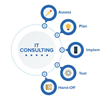A server constitutes a central part of a network which provides a platform to share files/folders/information from a central location preventing the need to maintain multiple copies of a file and the subsequent difficulties in tracking. Additionally over time the data stored on a computer becomes more valuable. In the event of any hardware failure there is a risk that data will be lost. By storing the data centrally a means of backing up the data becomes available and can be used for recovery subsequent to any hardware failure.
IT support for server platforms ensures businesses can operate smoothly with reliable, secure, and high-performing server environments. By offering installation, maintenance, security, and ongoing optimization, IT support teams help businesses reduce downtime, improve efficiency, and stay secure.
Server Installation and Configuration
IT support companies assist with the initial setup and configuration of server hardware and software. This includes:
- Physical Server Setup: Installing server hardware, including cabling, power, and physical deployment in data centers.
- Operating System Installation: Installing and configuring server operating systems such as Windows Server, Linux distributions (e.g., Red Hat, Ubuntu), or other proprietary server OS.
- Virtualization Setup: Configuring virtual servers using hypervisors like VMware, Hyper-V, or KVM, enabling multiple virtual machines (VMs) to run on a single physical server.
Server Monitoring and Maintenance
Proactive monitoring and regular maintenance are key to minimizing downtime and ensuring optimal server performance:
- Performance Monitoring: Real-time monitoring of CPU, memory, disk usage, and network traffic to detect performance bottlenecks.
- Health Checks: Regular inspections of server hardware (disks, RAM, power supplies) and software (OS, services) to prevent failures.
- Patch Management: Regularly updating the server operating system and software applications with security patches and updates to protect against vulnerabilities.
Server Security Management
Servers are frequent targets of cyberattacks, so ensuring their security is paramount. IT support teams implement several security measures, including:
- Firewall Configuration: Implementing firewalls to control access to the server, both at the network and host level.
- Access Control: Using role-based access control (RBAC), multi-factor authentication (MFA), and strict permissions to limit access to sensitive server resources.
- Security Audits: Conducting regular security audits, vulnerability assessments, and penetration testing to identify and mitigate risks.
- Intrusion Detection and Prevention Systems (IDPS): Deploying systems to detect and prevent unauthorized access to server infrastructure.
Backup and Disaster Recovery
IT support for servers includes ensuring business continuity in case of hardware failures or disasters:
- Data Backup Solutions: Implementing backup solutions that provide automatic, scheduled backups of critical server data. This can include both on-premise and cloud-based backup solutions.
- Disaster Recovery Plans (DRP): Creating and testing disaster recovery plans to quickly restore server functionality after hardware failure, data corruption, or other incidents.
- High Availability (HA) and Failover: Implementing high availability solutions using technologies like clustering and failover to ensure continuous server uptime in case of a failure.
Server Virtualization and Cloud Integration
Virtualization technologies and cloud computing have become essential for efficient resource management:
- Server Virtualization: IT support teams set up and manage virtualized environments to optimize hardware usage, increase scalability, and reduce costs. This includes managing virtual machine snapshots, resource allocation, and clustering.
- Cloud Integration: Migrating physical or virtual servers to cloud platforms (e.g., AWS, Azure, Google Cloud) or setting up hybrid server infrastructures that combine on-premise and cloud resources.
Performance Optimization
IT support teams help businesses optimize the performance of their servers for higher efficiency:
- Resource Allocation: Fine-tuning CPU, memory, and storage allocation to avoid overloading or underutilizing resources.
- Load Balancing: Implementing load balancers to distribute workloads evenly across servers, preventing any single server from becoming overloaded and improving performance for end users.
- Database Optimization: Monitoring and optimizing database performance by tuning queries, indexing, and storage options.
Storage and File Management
Managing storage efficiently is essential for server operations:
- Storage Area Networks (SAN) and Network-Attached Storage (NAS): IT support helps businesses configure and maintain SAN and NAS systems to ensure fast, reliable, and scalable storage.
- Data Management: Setting up secure and efficient data access, sharing, and archival solutions, including automated cleanup and file versioning.
Server Migration and Upgrades
Server platforms occasionally need to be migrated or upgraded to new hardware or software environments:
- Server Migration: IT support teams plan and execute migrations between server platforms, whether it’s from on-premise to cloud, from legacy systems to modern platforms, or from one data center to another.
- Upgrades: Keeping servers up-to-date by upgrading hardware components (e.g., adding more RAM or faster CPUs) and software (e.g., moving from older versions of server OS to newer versions).
Server Troubleshooting and Repair
When issues arise, IT support teams provide quick troubleshooting and repair services:
- Diagnostic Tools: Using advanced monitoring and diagnostic tools to identify and resolve performance issues, software conflicts, and hardware failures.
- 24/7 Support: Offering round-the-clock support to ensure that server issues are resolved swiftly, minimizing disruption to business operations.






